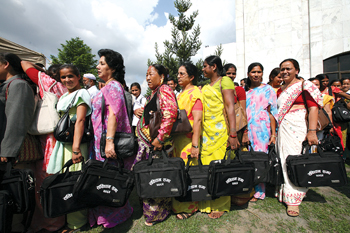
NT ARCHIVE
When the interim electoral council led by the Chief Justice announced the date for CA elections in mid-June, we all heaved a collective sigh of relief. There was reason to hope that the political stalemate and prolonged uncertainty might end.
But just when it looked like the country and its politics might finally be moving in the right direction, things are falling apart again. With a little over four months for the 19 November polls, the political parties are stuck again over the size of the CA, the delineation of constituencies, and the threat by the CPN-M to sabotage polls.
The political leadership has once more demonstrated its unwillingness to learn from past mistakes. They should have known that, like in 2008, the debate over constituencies would be highly divisive.
Although Clause 3 in the 11-point agreement says the number of electoral constituencies shall remain the same, parties are again playing politics with it. The Constituency Delineation Commission (CDC) could have been set up in mid-March immediately after Khil Raj Regmi was appointed instead of waiting till June.
The Madhes-based parties demand that the Tarai get a total of 120 out of the 240 constituencies in the first-past-the-poll (FPTP) ballot, so the CDC will have to negotiate hard with politicians as it tries to stay true to the interim constitution in deciding how to distribute the 35 available seats among districts that have seen a rise or reduction in population in the 2011 census. But there isn’t enough time to get into that now.
When the CA failed to draft a constitution in May last year, most Nepalis blamed the 601 lawmakers for squandering time and money. However, it wasn’t the CA members’ fault, they were just obeying the party whips. Despite its flaws, the CA was the most inclusive assembly ever in Nepali history with 192 Janajati representatives, 196 Madhesis, and a 33 per cent strong women caucus. The future CA will need to be as, or even more, inclusive.
By slashing proportional representation seats from 335 in 2008 to 240 this year, many worry that historically marginalsed Nepalis (especially women and Dalits) will once again be left behind. But Krishna Khanal, professor of politics at Tribhuvan University, says the reduction in PR seats does not mean that we have to compromise on inclusiveness. “It’s not about numbers, more about political will,” he told me, “even with 100 PR seats, it’s possible to ensure that Nepalis from marginalised and backward communities are well represented.”
Setting a slightly higher quota than in the previous election on the per cent of female/Dalit/Janajati/Madhesi candidates each party must field in FPTP and PR ballots is the most obvious solution. For example, to achieve a 33 per cent female representation in the 491-member assembly, if six females are selected for the 11 nominated posts, then parties will have to field about 60 per cent female candidates in the FPTP race, and then make up the rest in the PR seats.?
Unlike in 2008, no party should be exempted from following the quota because of its small size. What would also help ensure greater inclusiveness is to require parties to use either a ranked PR list where voters know which candidates from marginalised groups are high on a given party’s list, or an open PR list where voters can directly pick a candidate instead of a party.
Beyond numbers and quotas, the fringe parties are becoming increasingly vocal and pose the biggest threat to elections in November. Although weaker in number than the ‘bracket’ Maoists, Mohan Baidya’s ‘dash’ Maoists still have enough influence and willing allies to derail the entire democratic process.
Even if elections do take place under these circumstances, writing a constitution in the absence of important political players who feel no sense of ownership towards it, is a recipe for future unrest. Former chief election commissioner Bhoj Raj Pokhrel says: “What use is a new constitution if opposition forces start burning the document the very next day?”
Pushpa Kamal Dahal could bring Baidya and friends into the fold, but what will Baidya ask in return? The NC and UML, for their part, are happy to see the Maoists stay split.
The CA met its ignominious end last year after 22 obdurate men couldn’t agree on the kind of federalism and form of governance. Whether Nepalis will queue again at polling booths this winter will depend on how quickly these very men demonstrate they have learnt from the past and want to build a future.
Other columns by Trishna Rana:
On life support
Arms and the men
The rot at the bottom